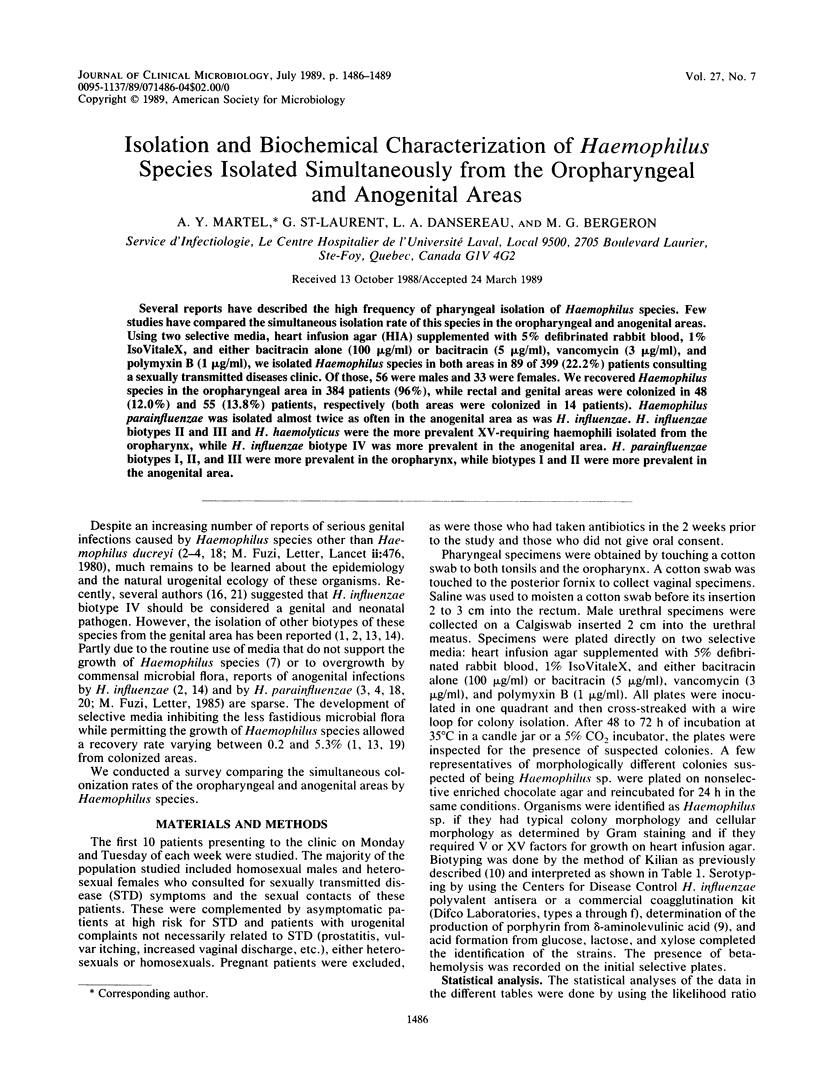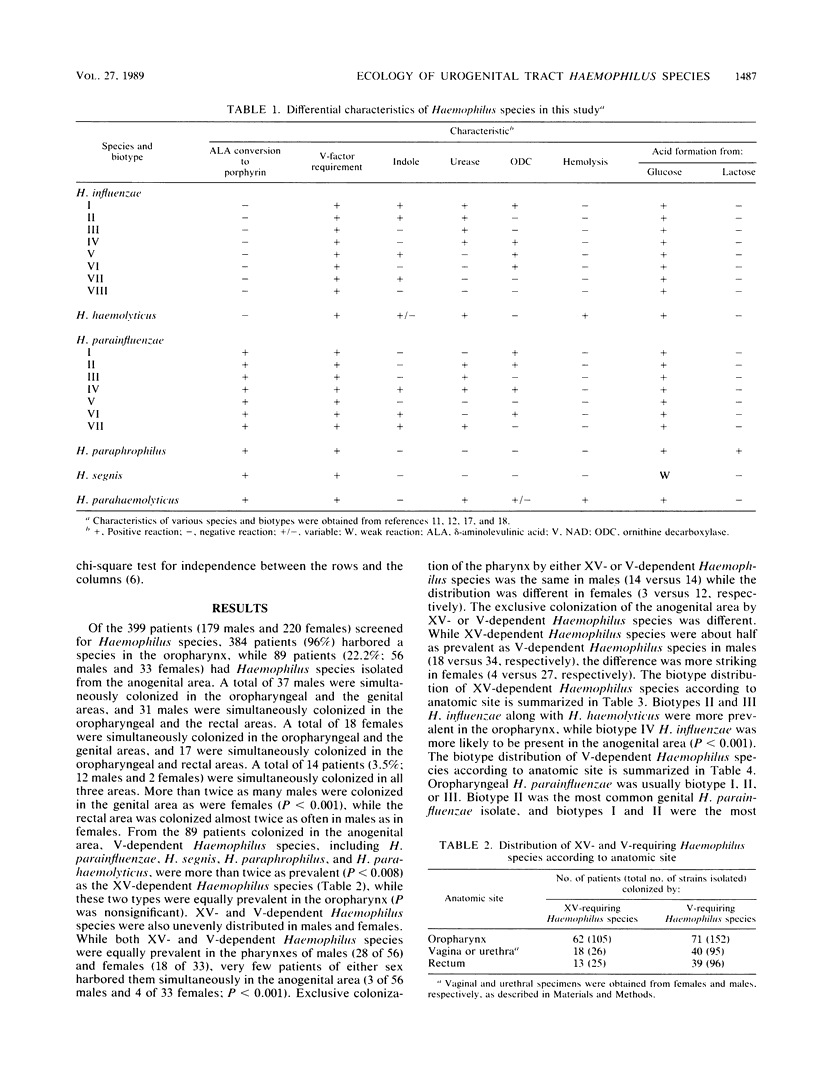Abstract
Several reports have described the high frequency of pharyngeal isolation of Haemophilus species. Few studies have compared the simultaneous isolation rate of this species in the oropharyngeal and anogenital areas. Using two selective media, heart infusion agar (HIA) supplemented with 5% defibrinated rabbit blood, 1% IsoVitaleX, and either bacitracin alone (100 micrograms/ml) or bacitracin (5 micrograms/ml), vancomycin (3 micrograms/ml), and polymyxin B (1 microgram/ml), we isolated Haemophilus species in both areas in 89 of 399 (22.2%) patients consulting a sexually transmitted disease clinic. Of those, 56 were males and 33 were females. We recovered Haemophilus species in the oropharyngeal area in 384 patients (96%), while rectal and genital areas were colonized in 48 (12.0%) and 55 (13.8%) patients, respectively (both areas were colonized in 14 patients). Haemophilus parainfluenzae was isolated almost twice as often in the anogenital area as was H. influenzae. H. influenzae biotypes II and III and H. haemolyticus were the more prevalent XV-requiring haemophili isolated from the oropharynx, while H. influenzae biotype IV was more prevalent in the anogenital area. H. parainfluenzae biotypes I, II, and III were more prevalent in the oropharynx, while biotypes I and II were more prevalent in the anogenital area.
Full text
PDF



Selected References
These references are in PubMed. This may not be the complete list of references from this article.
- Albritton W. L., Brunton J. L., Meier M., Bowman M. N., Slaney L. A. Haemophilus influenzae: comparison of respiratory tract isolates with genitourinary tract isolates. J Clin Microbiol. 1982 Nov;16(5):826–831. doi: 10.1128/jcm.16.5.826-831.1982. [DOI] [PMC free article] [PubMed] [Google Scholar]
- Albritton W. L., Hammond G. W., Ronald A. R. Bacteremic Haemophilus influenzae genitourinary tract infections in adults. Arch Intern Med. 1978 Dec;138(12):1819–1821. [PubMed] [Google Scholar]
- Blaylock B. L., Baber S. Urinary tract infection caused by Haemophilus parainfluenzae. Am J Clin Pathol. 1980 Feb;73(2):285–287. doi: 10.1093/ajcp/73.2.285. [DOI] [PubMed] [Google Scholar]
- Chowdhury M. N., Pareek S. S. Urethritis associated with Haemophilus parainfluenzae: a case report. Sex Transm Dis. 1983 Jan-Mar;10(1):45–46. doi: 10.1097/00007435-198301000-00012. [DOI] [PubMed] [Google Scholar]
- Dabernat H., Bauriaud R., Delmas C., Lareng M. B. Colonisation de l'enfant par Haemophilus; sérotypes, biotypes et sensibilité aux antibiotiques. Pathol Biol (Paris) 1983 Feb;31(2):103–106. [PubMed] [Google Scholar]
- Kawakami Y., Okimura Y., Kanai M. Occurrence and biochemical properties of Haemophilus species in pharyngeal flora of healthy individuals. Microbiol Immunol. 1982;26(7):629–633. doi: 10.1111/mim.1982.26.7.629. [DOI] [PubMed] [Google Scholar]
- Kilian M. A rapid method for the differentiation of Haemophilus strains. The porphyrin test;. Acta Pathol Microbiol Scand B Microbiol Immunol. 1974 Dec;82(6):835–842. doi: 10.1111/j.1699-0463.1974.tb02381.x. [DOI] [PubMed] [Google Scholar]
- Kilian M. A taxonomic study of the genus Haemophilus, with the proposal of a new species. J Gen Microbiol. 1976 Mar;93(1):9–62. doi: 10.1099/00221287-93-1-9. [DOI] [PubMed] [Google Scholar]
- Messing M., Sottnek F. O., Biddle J. W., Schlater L. K., Kramer M. A., Kraus S. J. Isolation of Haemophilus species from the genital tract. Sex Transm Dis. 1983 Apr-Jun;10(2):56–61. doi: 10.1097/00007435-198304000-00002. [DOI] [PubMed] [Google Scholar]
- Nuchowicz A., Vanoudenhove J. L., Serruys-Schoutens E. Infections gynécologiques à Haemophilus influenzae chez l'adulte. Trois observations. Presse Med. 1985 Feb 16;14(7):409–411. [PubMed] [Google Scholar]
- Palmer G. G. Haemophili in faeces. J Med Microbiol. 1981 Feb;14(1):147–150. doi: 10.1099/00222615-14-1-147. [DOI] [PubMed] [Google Scholar]
- Pinon G., Quentin R. Haemophilus influenzae et infections génitales: quel role pour le biotype IV? Presse Med. 1985 May 11;14(19):1101–1101. [PubMed] [Google Scholar]
- Sottnek F. O., Albritton W. L. Haemophilus influenzae biotype VIII. J Clin Microbiol. 1984 Oct;20(4):815–816. doi: 10.1128/jcm.20.4.815-816.1984. [DOI] [PMC free article] [PubMed] [Google Scholar]
- Sturm A. W. Haemophilus influenzae and Haemophilus parainfluenzae in nongonococcal urethritis. J Infect Dis. 1986 Jan;153(1):165–167. doi: 10.1093/infdis/153.1.165. [DOI] [PubMed] [Google Scholar]
- Sturm A. W. Isolation of Haemophilus influenzae and Haemophilus parainfluenzae from genital-tract specimens with a selective culture medium. J Med Microbiol. 1986 Jun;21(4):349–352. doi: 10.1099/00222615-21-4-349. [DOI] [PubMed] [Google Scholar]
- Wallace R. J., Jr, Baker C. J., Quinones F. J., Hollis D. G., Weaver R. E., Wiss K. Nontypable Haemophilus influenzae (biotype 4) as a neonatal, maternal, and genital pathogen. Rev Infect Dis. 1983 Jan-Feb;5(1):123–136. doi: 10.1093/clinids/5.1.123. [DOI] [PubMed] [Google Scholar]
- van Embden J. D., van Klingeren B., Dessens-Kroon M., van Wijngaarden L. J. Penicillinase-producing Neisseria gonorrhoeae in the Netherlands: epidemiology and genetic and molecular characterization of their plasmids. Antimicrob Agents Chemother. 1980 Nov;18(5):789–797. doi: 10.1128/aac.18.5.789. [DOI] [PMC free article] [PubMed] [Google Scholar]


